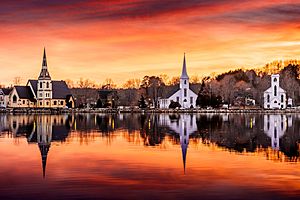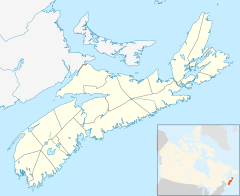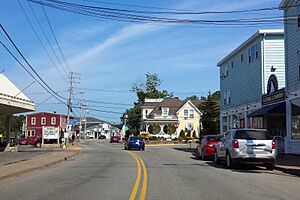Mahone Bay, Nova Scotia facts for kids
Quick facts for kids
Mahone Bay
|
||
|---|---|---|
|
Town
|
||

The Famous Three Churches of Mahone Bay
|
||
|
||
| Motto(s):
"A Treasure Since 1754"
|
||
| Country | Canada | |
| Province | Nova Scotia | |
| County | Lunenburg County | |
| Founded | 1754 | |
| Incorporated | March 31, 1919 | |
| Area
(2021)
|
||
| • Total | 3.12 km2 (1.20 sq mi) | |
| Highest elevation | 24 m (79 ft) | |
| Lowest elevation | 0 m (0 ft) | |
| Population
(2021)
|
||
| • Total | 1,064 | |
| • Density | 341.4/km2 (884/sq mi) | |
| Time zone | UTC-4 (AST) | |
| Postal code span |
B0J
|
|
| Area code(s) | 902 | |
| Telephone Exchanges | 521, 624, 627 | |
| Median household income (2005) | $36,374 | |
| Total private dwellings | 571 | |
| Website | townofmahonebay.ca | |
Mahone Bay is a charming town located on the northwest shore of Mahone Bay in Nova Scotia, Canada. It's part of Lunenburg County. This town is famous for its beautiful scenery and has been a popular spot for tourists for a long time.
Recently, Mahone Bay has also become known as a great place for new businesses and creative people. In fact, it was the fastest-growing town in Nova Scotia according to the 2016 census, with its population increasing by almost 10%!
Contents
Mahone Bay's Past
The land where Mahone Bay sits today was once covered by a huge sheet of ice. This ice began to melt about 13,500 years ago. By 11,000 years ago, most of the ice was gone. The first people to live here were Paleo-Indians, who arrived soon after the ice disappeared.
The Mi'kmaq People
Mahone Bay is part of the traditional lands of the Mi’kmaq people, called Mi’kma’ki. They have lived here for over 13,500 years. Before Europeans arrived, Mi’kmaq families lived in and around what is now Mahone Bay.
- Summer Homes: A place called Indian Point, just outside the town, was an important summer village. The Mi’kmaq enjoyed the calm waters and plenty of food sources there.
- Winter Homes: In winter, they would move away from the coast. They used the rivers that flow into Mahone Bay harbour to travel inland. Many Mi’kmaq people still live in the area today.
European Settlers Arrive
In the mid-1700s, British officials invited people from Europe to move to Nova Scotia. They promised land, food, and farm animals. Between 1750 and 1752, more than 2,200 "Foreign Protestants" came from places like Germany, Switzerland, and France to Halifax.
In 1753, many of these new immigrants moved from Halifax to Lunenburg. This was meant to be the main settlement. The first people to arrive in the Mahone Bay area were led by a sailor named Ephraim Cook. These settlers were mostly German, Swiss, and Montbéliardais.
Early Challenges
During the French and Indian War, there were several attacks on the Protestant settlers in the Lunenburg area. These attacks were carried out by Native and Acadian (Catholic) groups.
- Island Attacks: One attack, known as the Raid on Lunenburg (1756), happened near Mahone Bay. It took place off the shores of Covey Island and [John] Rous Island.
- Village Attack: On August 24, 1758, eight Mi'kmaq attacked homes in the village of Mahone Bay. Sadly, three people lost their lives in this event.
Over time, mills were built where the two rivers meet Mahone Bay. A separate community slowly grew there. It had blacksmiths, shops, a large school, churches, and places where ships were built.
Mahone Bay's Shipbuilding History
Mahone Bay has a long and proud history of building boats. It all started with the Mi’kmaq people, who were skilled at making birch bark canoes.
Early Shipyards
The British began the first large-scale production of ships. They set up sawmills to cut wood for shipbuilding. The earliest official record of a ship built in Mahone Bay is from 1817.
- Growing Industry: By 1850, at least 43 ships had been built by small shipyards in the Mahone Bay area. Larger shipyards then started to appear.
- Types of Ships: These shipyards mainly built schooners and smaller vessels. They were used for fishing and moving goods.
- Longer Journeys: As time went on, shipbuilders started making larger vessels. These bigger ships were used for trading over longer distances, reaching places like the United States and the West Indies.
From Sail to Power
After World War I, there wasn't much demand for sailing ships anymore. So, the local shipyards changed what they built. They started designing and building power vessels, which used engines instead of sails. These boats were used for fishing and transporting goods. Some were even used for rum-running during a time when alcohol was illegal!
Shipyards continued to build vessels during World War II. At this time, as many as 500 people worked in Mahone Bay's shipyards.
Modern Boat Building
Even though fishing boats were still built until 1967, the industry changed after World War II. It focused more on building boats for fun, called pleasure boats.
- Fiberglass Boats: Fiberglass sailboats were built at the site of the current RPS Composites factory. Companies like Paceship Yachts made these boats.
- Plywood Boats: Mahone Bay Plycraft Co. built thousands of laminated plywood "runabout" boats. They did this from 1949 to 1962.
- End of an Era: Commercial boat building in Mahone Bay ended around 1975. This was when the last fiberglass yachts were built at Paceship.
Some of the major shipyards between 1850 and 1942 included:
- Obed H. Ham Yacht Works
- Abraham Ernst/Erst & Sons/Ernst Shipbuilding
- John Zwicker
- John Mclean and Sons Shipyard
- Elkanah Zwicker/Titus Langilee
- Henry Schnare
Mahone Bay Today
Today, Mahone Bay is still known for its history of wooden boat building. This was once the town's main industry. The Mahone Bay Museum shares and explains this history in great detail. For many years, the town celebrated its shipbuilding past with the "Mahone Bay Wooden Boat Festival."
The view across the harbour is very famous. You can see three beautiful churches:
This image of the three churches has become a symbol of Nova Scotia. It is often photographed and appears on postcards and calendars.
The town also has many nice shops and restaurants. Most of these are set up to attract tourists. Some of them even close during the winter months. Mahone Bay also has a factory that makes plastic products.
Mahone Bay's Population
|
|||||||||||||||||||||||||||||||||||||||||||||||||||||||||
In the 2021 Census, Statistics Canada reported that Mahone Bay had a population of 1,064 people. These people lived in 522 of the town's 599 homes. This means the population grew by 2.7% since the 2016 census, when it was 1,036 people.
Mahone Bay covers an area of 3.12 square kilometers (about 1.2 square miles). In 2021, this meant there were about 341 people living in each square kilometer.



